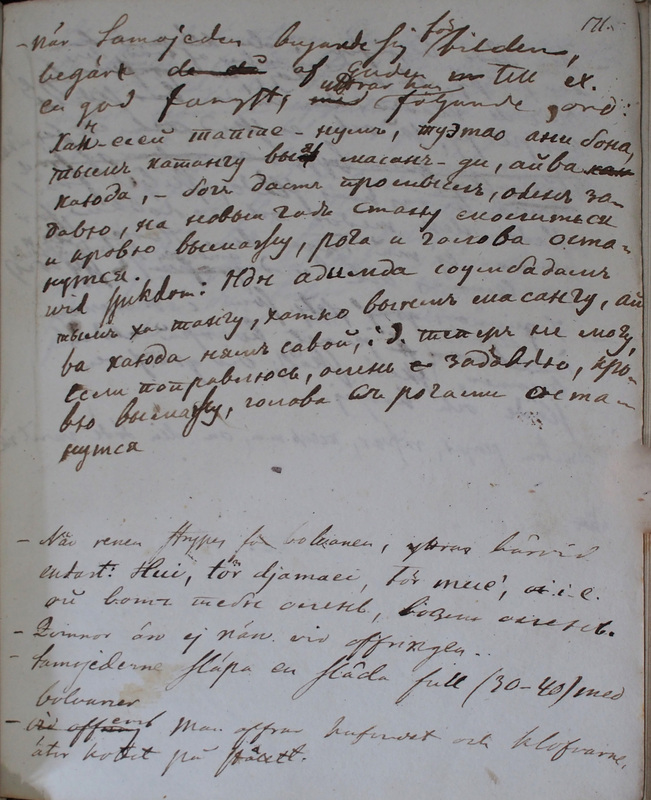Ethnographiska, historiska och statistiska anmärkningar. 171
Title
Ethnographiska, historiska och statistiska anmärkningar. 171
Description
|
När
Samojeden bugande sig för bilden,Here Castrén is describing short sacrificial prayers, typical of the Nenets rituals, which can take place either in the tundra or in the camp. As seen, the sacrifices can be related, for example, to luck in livelihood and health. In the prayer, the spirit in question is briefly addressed. For similar prayers, see Lehtisalo 1947: 547–550.
begär de då af Guden till ex. en god fångst, med yttrar han följande ord: Хан-есей тапте-нумь, туэтао ани бона,
- богъ дасть промысель, олень зо-тысемъ хатангу выя масанъ-ди, айвахаюда, TN Ханесэй табʺта Нум, туетав аниʹ пона, тымʹ хаданнгу, вэя’ масан’’-диʹ, нгэва хаюда ʻWhen Num gives prey, I will pray next year, I will kill a reindeer, smear its blood [on the idol], leave the head.’ (RL, Tas, KL)
давю, на новыи годъ стану молиться и кровю вымажу, рога и голова останутся. Vid sjukdom: Нян адимда соумбадамъ тымь ха тангу, хатко выемъ масангу, айва хаюда нямъ савой,
id. теперь не могу, если поправлюсь, олень задавлю, кро-вю вымажу, голова съ рогами оста-нутся.TN Нян адимда, савумдабaмʹ, тымʹ хаданггув, хадкo вэямʹ масанггу, нгэваʹ хаюда, нямдсавэй ʻIf I get better, I will kill a reindeer, definitely smear its blood [on the idol], and leave the head and antlers.’ (RL, TaS, KL)
|
When a Samoyed bows to an image and asks the god for, for example, a good catch, he utters the following words: Хан-есей тапте-нумь, туэтао ани бона, тысемъ хатангу выя масанъ-ди, айвахаюда. ʻWhen Num gives prey, I will pray next year, I will kill a reindeer, smear its blood [on the idol], leave the head.’In the event of illness: Нян адимда соумбадамъ тымь ха тангу, хатко выемъ масангу, айва хаюда нямъ савой. ʻIf I get better, I will kill a reindeer, definitely smear its blood [on the idol], and leave the head and antlers.’ |
|
När
renen
strypes för
As implied, a reindeer is not always sacrificed. A sacrifice without a sacrificial animal is called TN хаңор, whereas TN ханʹ denotes a ritual with an animal sacrifice. A sacrificial reindeer is traditionally killed by strangling it. Typically, the idols are fed with blood or fat, which are spread on the idol, but cooked food can also be served to an idol. In addition, reindeer skulls and antlers are left in the place (Chomič 1977).
bolvanen,
yttras härvidRu bolvan ʻidol’ was widely used in the North to denote the different kinds of images of deities among the northern indigenous peoples. TN сядэй and хэхэ would correspond to ‘bolvan’. Of these, сядэй refers explicitly to the images, whereas хэхэ is a more general category referring to objects and phenomena related to the other world. Хэхэ is also used to denote family-related idols. Generally, the images of deities can be made of wood or stone. They can be remarkable stones in the middle of the tundra or bigger man-made anthropomorphic carvings. These are usually offered to when they are met in the tundra. Additionally, there are smaller images that are carried along either in TN хэхэʹ хан or inside clothes and left in sacred places. (Lehtisalo 1924: 147–148; Lehtisalo 1956: 431; Chomič 1966: 199–208; Lar 2004)
endast: Hui, tör djamaei, tör mue',
TN Хoй, тэр тямэйʺ, тэр мыʺ ʻHow, here’s the reindeer, take the reindeer!’ (RL, TaS, KL)
ой вотъ тебе олень, возми олень. Qvinnor
äro ej närv[arande] vid offringen.This could go back to the complex of TN сяʺмэй [Qvinnor].
Samojederne släpa en släda
full (30-40) medTN хэхэʹ хан ʻsacred sledge’. A special sledge for the religious items of the family, especially different TN хэхэʹ ʻidols’, and other ritual necessities. During the movement of the camp, хэхэʹ хан comes behind the head of the camp. In the camp, хэхэʹ хан is placed behind the tent and its sacred place, TN си, drawing an imaginary line that the women should not cross. (Chomič 1966: 206; Golovnev, Kukanov & Perevalova 2018: 214–215)
bolvaner. |
When a reindeer is strangled for the bolvan, they only say: Hui, tör djamaei, tör mue' ʻHow, here’s the reindeer, take the reindeer!’
Women are not present at the sacrifice. The Samoyeds drag a sledge full (30-40) of bolvaner. |
| Vid offrning Man offrar hufvudet och klöfvarne, äter köttet på stället. |
When sacrificing one offers the head and the hooves; the meat is eaten on the spot. |

